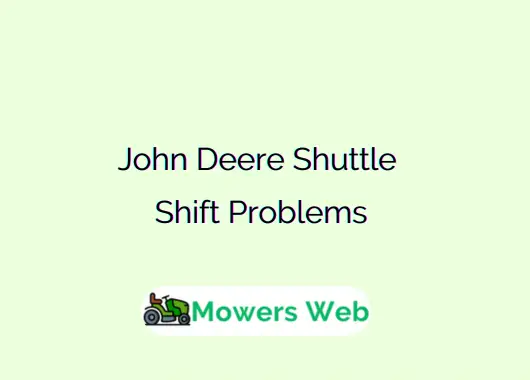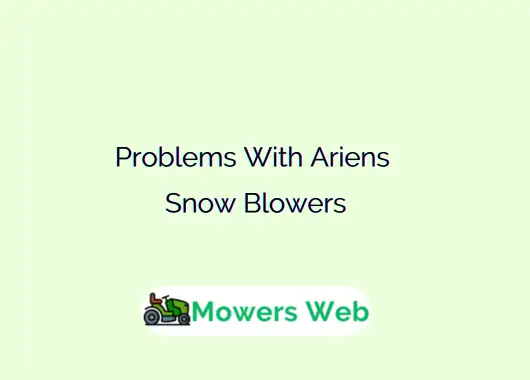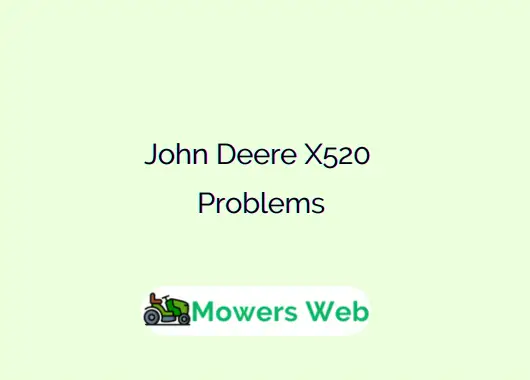Over time, components in the system can wear or malfunction, leading to shifting issues. This guide explores the most common John Deere shuttle shift problems, their causes, and practical solutions.
John Deere Shuttle Shift Problems
1. Shuttle Shift Won’t Engage (No Forward or Reverse)
Symptoms:
- The tractor doesn’t move when the shuttle lever is shifted.
- Both forward and reverse fail to engage.
Possible Causes:
- Low or dirty transmission fluid.
- Failed solenoid or shuttle valve.
- Electrical connection issues.
- Internal hydraulic leak or clutch pack wear.
Fixes:
- Check and replace low or contaminated hydraulic fluid.
- Inspect solenoids for continuity using a multimeter.
- Clean or replace dirty shuttle control valves.
- Test hydraulic pressure to verify clutch pack function.
Tip: Always ensure the neutral safety switch is functioning correctly; a faulty switch can prevent engagement.
Related John Deere Power Reverser Transmission Problems(Fixed)
2. Tractor Jerks When Shifting Between Forward and Reverse
Symptoms:
- Sudden jerks or lurching during direction changes.
- Harsh shifting noise or clunk.
Possible Causes:
- Incorrect clutch pressure calibration.
- Dirty hydraulic oil or filter restriction.
- Worn clutch plates.
- Faulty shuttle modulation valve.
Fixes:
- Change the transmission filter and hydraulic fluid.
- Check shuttle modulation valve for debris or sticking.
- Adjust clutch pressure or have a technician recalibrate electronically controlled valves.
- Replace clutch packs if severely worn.
Pro Tip: Regular oil and filter changes reduce shuttle shock and extend clutch life.
Related Lawn Mower Dies When Blades Engaged(8 Causes + Solutions)
3. Shuttle Works in One Direction Only
Symptoms:
- Forward gear works, but reverse does not, or vice versa.
Possible Causes:
- One directional clutch pack is burned out.
- Solenoid or wiring harness failure on one side.
- Faulty shuttle lever switch.
Fixes:
- Test solenoids for power and continuity.
- Inspect harnesses and connectors for corrosion.
- Replace defective directional clutch or solenoid.
Note: If you hear the solenoid click when shifting but no movement occurs, hydraulic pressure loss may be the culprit.
Related John Deere Regen Problems(7 Causes + Solutions)
4. Delayed Engagement or Slipping
Symptoms:
- Delay before the tractor starts moving after shifting.
- The tractor feels weak or slips under load.
Possible Causes:
- Low hydraulic pressure.
- Internal clutch leakage.
- Dirty fluid or clogged suction screen.
- Worn clutch discs.
Fixes:
- Check fluid level and top up if needed.
- Replace the transmission filter and clean the suction screen.
- Pressure test the system to confirm leaks or weak clutches.
- Rebuild or replace worn clutch packs.
Tip: Use only John Deere Hy-Gard or manufacturer-approved fluid, as using incorrect oil can lead to slippage or premature wear.
5. Shuttle Lever Feels Stiff or Hard to Move
Symptoms:
- The lever feels sticky or jammed.
- Shifting takes excessive force.
Possible Causes:
- Mechanical linkage binding or worn pivot joints.
- Dirt or rust buildup around the lever assembly.
- Cable misalignment or internal wear.
Fixes:
- Lubricate all linkage joints and moving parts.
- Replace worn cables or plastic bushings.
- Clean lever housing and remove dirt buildup.
Preventive Step: Regular lubrication prevents binding and keeps shifting smooth.
Related John Deere 310 Backhoe Wont Start(8 Causes + Solutions)
6. Intermittent Shuttle Operation
Symptoms:
- Tractor sometimes engages and sometimes doesn’t.
- Works fine after restarting the machine.
Possible Causes:
- Loose electrical connection or ground wire.
- Failing seat switch or safety circuit.
- Faulty temperature or pressure sensor.
Fixes:
- Tighten all electrical connectors.
- Test the seat safety switch and replace it if needed.
- Scan for fault codes if the tractor uses an electronic control module (ECM).
Note: Inconsistent electrical signals are a common culprit for intermittent shuttle issues.
Related Excessive Vibration on John Deere 345(4 Causes + Solutions)
Preventive Maintenance Tips
To avoid John Deere shuttle shift problems, proper maintenance is essential. Follow these steps to extend your system’s life:
- Change hydraulic fluid and filters regularly. Dirty oil is the leading cause of shuttle valve sticking.
- Use OEM filters and fluids. John Deere-approved Hy-Gard transmission oil ensures the right viscosity and protection.
- Inspect wiring harnesses and connectors. Electrical corrosion often mimics mechanical failure.
- Monitor hydraulic pressure. A drop in pressure usually signals early wear.
- Engage the shuttle smoothly. Avoid sudden directional changes while the tractor is still moving.
FAQs
How does a John Deere shuttle shift work?
A John Deere shuttle shift uses a hydraulic or electro-hydraulic system that allows the operator to change direction between forward and reverse without using the clutch pedal. The system works through a shuttle lever located near the steering wheel, which controls directional clutch packs or solenoids.
When you move the lever, hydraulic pressure is redirected to engage the forward or reverse clutch, allowing smooth directional changes, ideal for loader or field work.
What are the common problems with John Deere tractors?
Common problems with John Deere tractors include shuttle shift issues such as failure to engage, jerky shifting, or slipping due to low or dirty hydraulic fluid. Other frequent concerns are electrical faults in solenoids or safety switches, hydraulic leaks, overheating, and wear in clutch packs. Additionally, older models may face problems with fuel delivery systems, PTO engagement, and steering components. Regular maintenance and timely fluid replacement can prevent most of these issues.
How to unlock hydrostatic transmission on a John Deere?
To unlock the hydrostatic transmission, locate the freewheel or tow valve lever (usually at the rear or near the transmission housing). Move the lever to the “freewheel” or “tow” position, which releases hydraulic pressure and allows the tractor to roll freely.
Always ensure the tractor is on level ground, and never tow it long distances in this mode, as it can damage the transmission. Once you’re done moving it, return the lever to the normal operating position before restarting.
Related John Deere Oil Filter Cross Reference Chart(For All Brands)
How to shift a shuttle shift tractor?
To shift a shuttle shift tractor, start the engine, set the gear or range lever to the desired position, and use the shuttle lever near the steering wheel to switch between forward and reverse.
You do not need to press the clutch pedal for each directional change. Simply move the lever smoothly while the tractor is at low RPMs or stopped for a smooth transition. Avoid sudden changes while moving at high speed to prevent stress on the clutch packs.
Do you have to use the clutch on a shuttle shift tractor?
No, you don’t have to use the clutch on a shuttle shift tractor for normal forward or reverse direction changes. The system is designed to shift hydraulically or electronically.
However, you should still use the clutch when changing range gears or starting the engine. For smoother operation and to reduce wear, always shift directions at low RPMs and avoid rapid transitions under heavy load.
Final words
Shuttle shift systems make John Deere tractors more efficient and easier to operate, but they also require regular care to prevent failure. Most John Deere shuttle shift problems stem from low fluid, dirty filters, solenoid malfunctions, or worn clutch packs. By maintaining the system and addressing minor issues early, you can avoid costly repairs and downtime.




